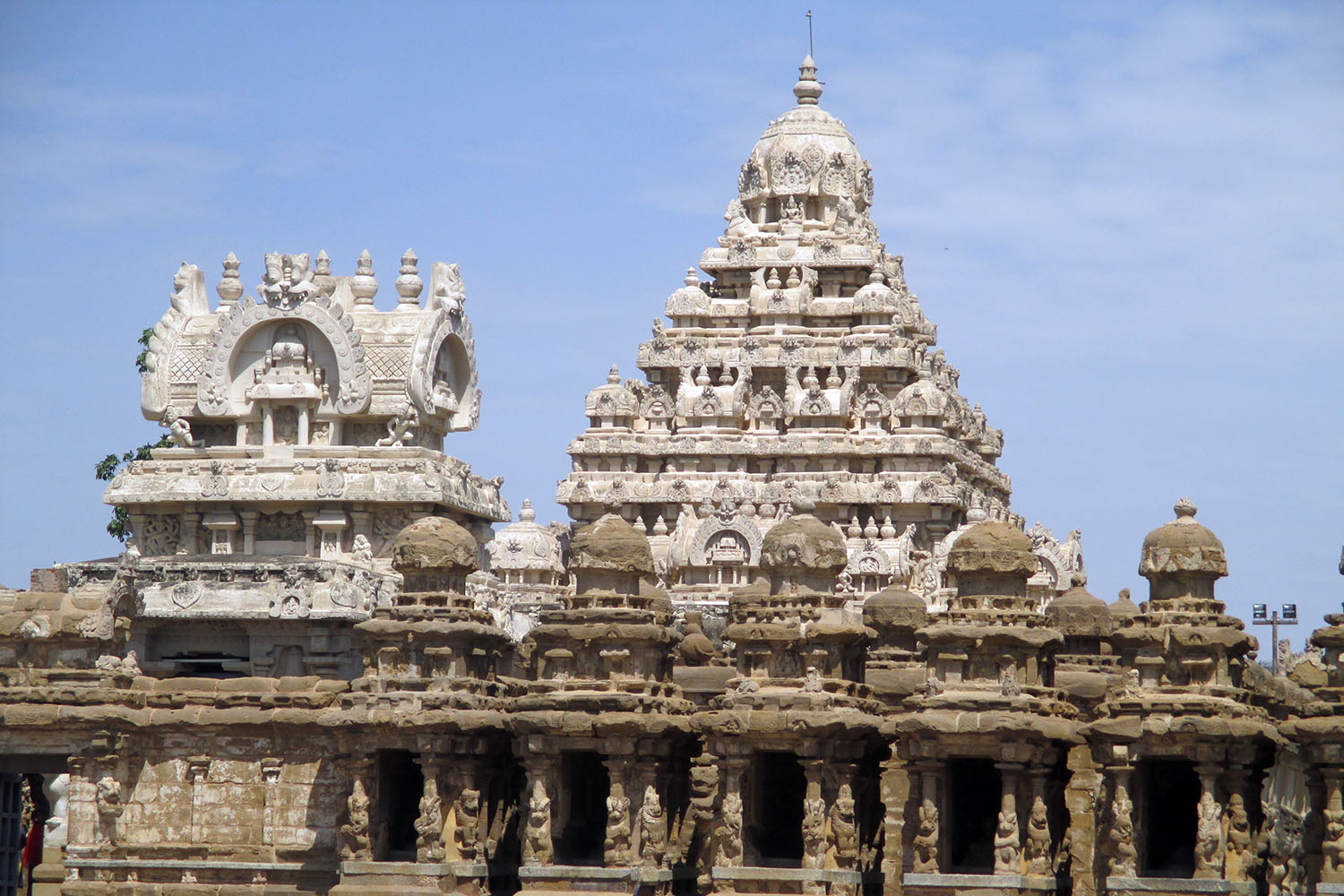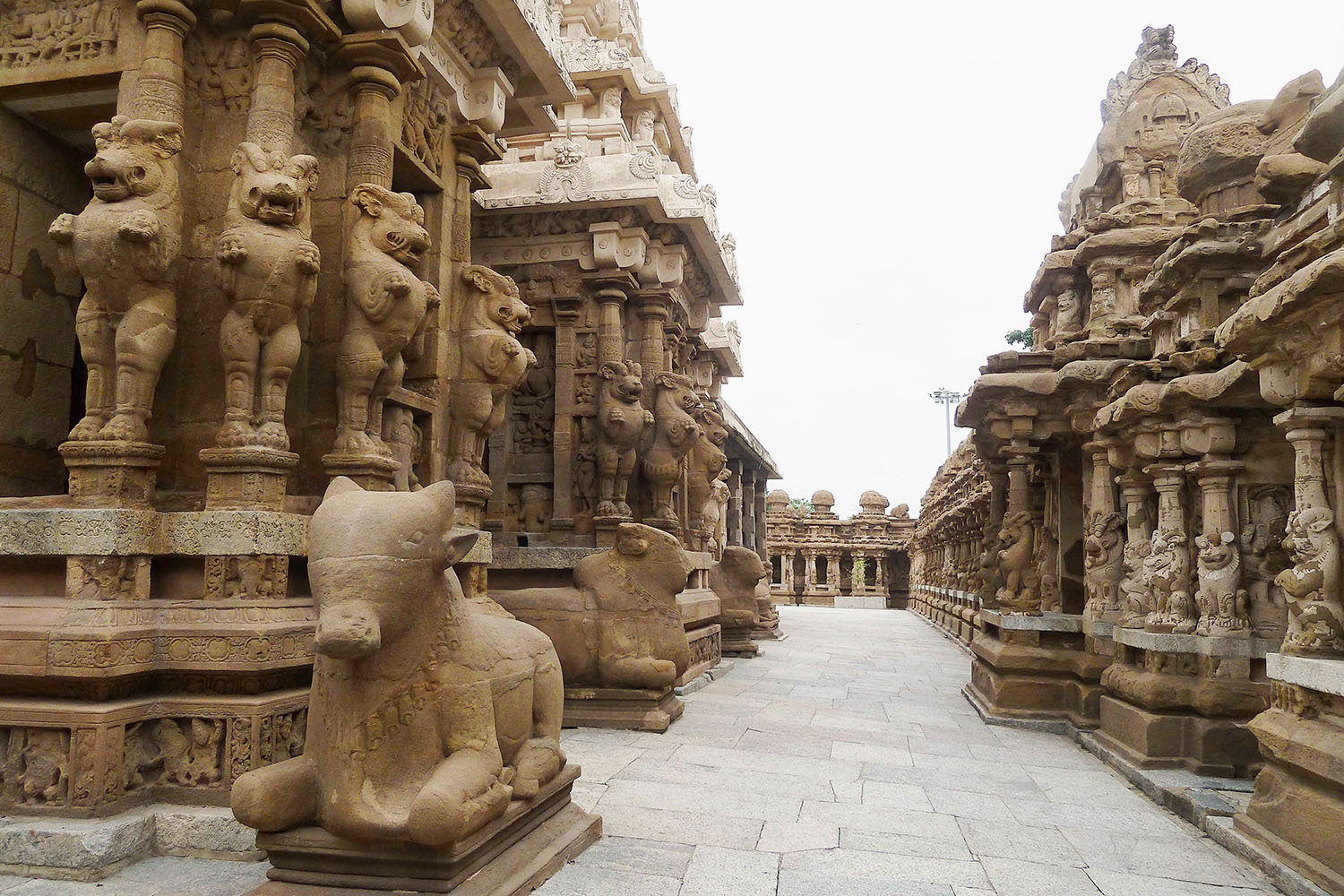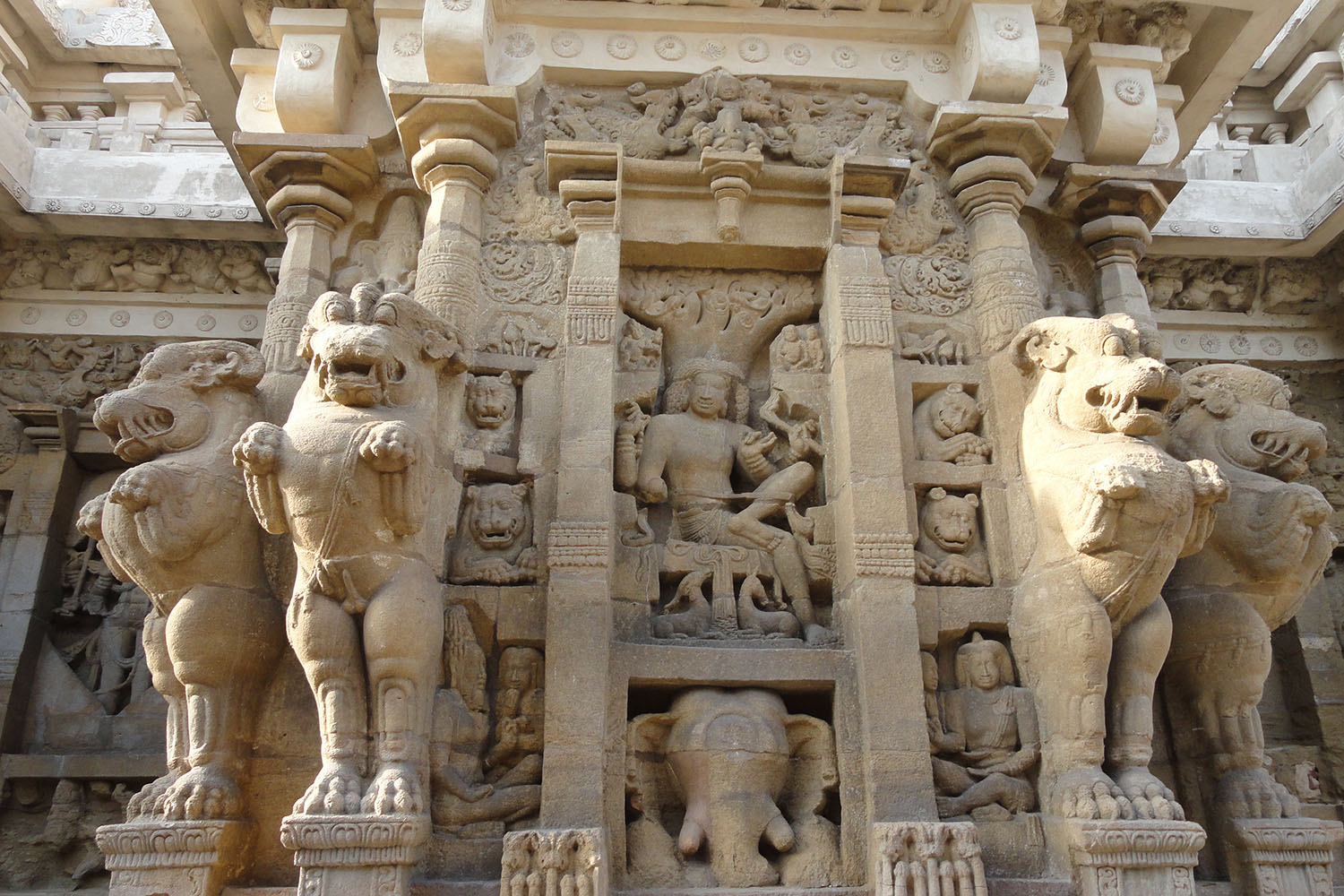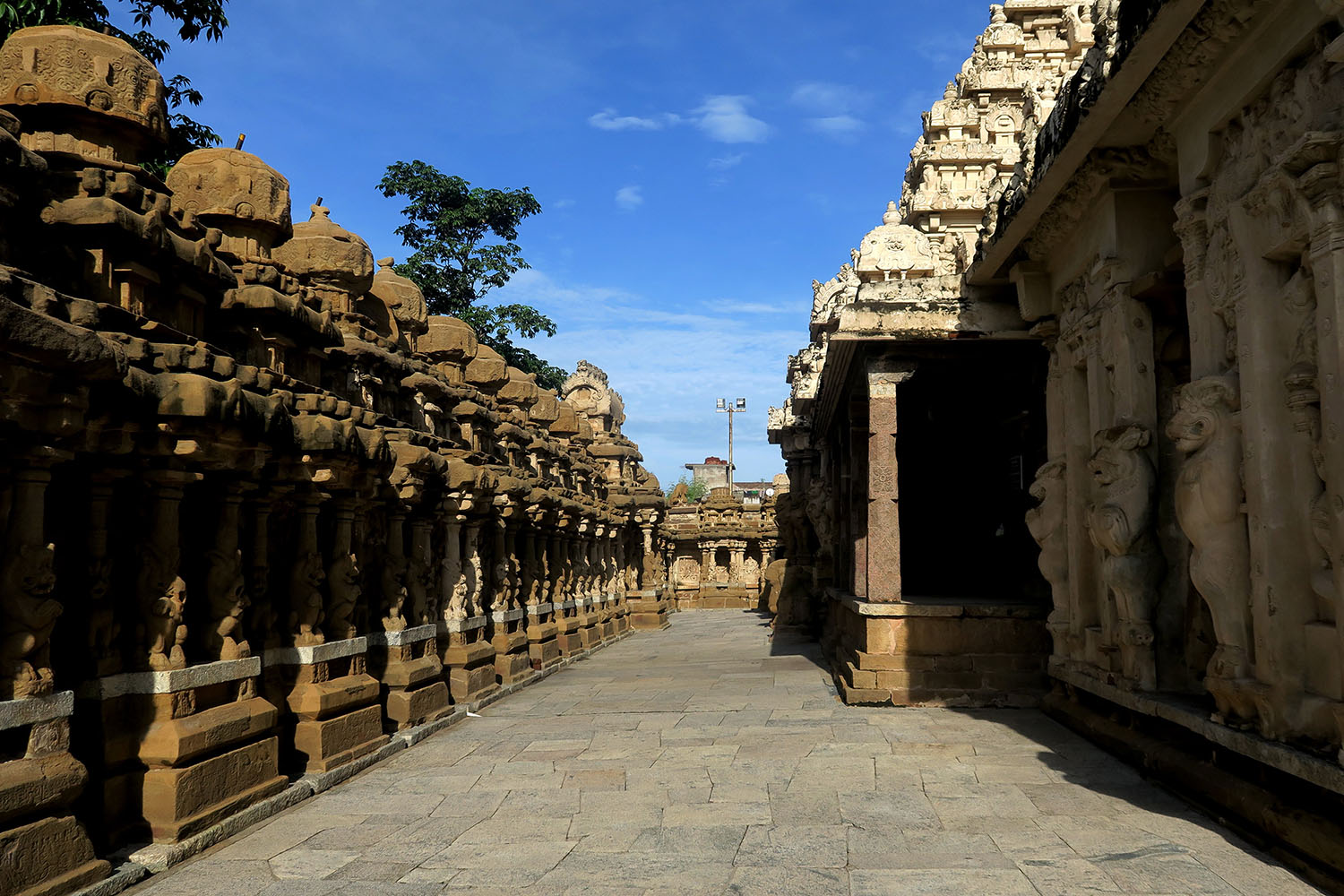ARTICLE
Kailasanathar Temple, Kanchipuram
An eighth-century Shaivite temple constructed with the patronage of the Pallava King Narisimhavarman II, also known as Rajasimha, the Kailasanathar temple is the oldest known temple in Kanchipuram, Tamil Nadu. The temple was built along the banks of the Vegavathi river between 700 and 728 CE, and is a prime example of Dravida temple architecture. Among the earliest structural sandstone temples in South India built on a large scale, the Kailasanathar temple establishes two characteristic features that were later shared by most structural Pallava temples: pillars and pilasters with a stylised lion or horned-lion base (simhapada or vyalapada) and a plinth of granite to prevent seepage and stabilise the superstructure. Although the architectural style and general plan were a legacy of the early Pallava period rock-cut temples, the medium of sandstone rendered these later temples more suitable for sculptural ornamentation. Although the temple was originally named after its patron — Rajasimha Pallaveshvara — the later and now-popular moniker of Kailasanathar was derived from an inscription that described its lofty vimana as touching the realm of Shiva (Kailasa).
Oriented east–west, the original temple complex consisted of a garbhagriha and a detached mahamandapa, which were later connected by a half-hall or ardhamandapa. Along the inner side of the prakara or perimeter wall of this main court, are a continuous series of fifty-eight alcoves housing sub-shrines, or devakulikas. Later additions to the complex include a low slung entranceway or gopuram encompassing a secondary shrine, and a small forecourt in front of this. The smaller shrine was conceived as a much reduced version of main shrine, with a barrel-vaulted roof form (shala) that echoes the large eastern gopuram. At the centre of the northern wall is a similar gopuram, which has been blocked up and is no longer accessible. The devakullikas on the north and south side that are in line with the garbhagriha, are larger and are surmounted by more prominent alpa-vimana roof forms, mirroring in a reduced form the scheme of the main four-storeyed vimana. A set eight devakulikas, believed to have been commissioned by Rajasimha’s queens, asymmetrically flank the eastern entrance: two on the south side and six lined along the north. A Nandi statue faces the temple across the main courtyard adjacent to the stepped temple tank and a carved well.
The garbhagriha houses the main deity: a 2.5 metre high and sixteen-faceted polished black stone lingam. On the back wall is a Somaskanda relief. The aditalas or skirting features reliefs of various celestial figures rendered in great detail. The vimana has on its exterior seven sub-shrines — four corner shrines and three central shrines — each offset by three pairs of cantoning vyala pillars and enclosing two niches on each of the three sides. The two subsidiary shrines on the east have now been engulfed by the ardhamandapa structure and are accessible only through it. Shaivaite iconography densely populates the walls of the main shrine, the subsidiary shrines, and the pilasters and the wall niches between them. In the shrines are monumental and finely picked out sculptures of aspects of Shiva such as Dakshinamurthi, Bhikshatanamurthi, Tripurantakamurti, Kalasamharamurti, Gangadharamurthi, and Urdhvathandavamurthi, amongst others. In the alcoves are similarly large sculptures of Shiva as Uma-maheswara, Lingodbhavamurti, Tripurantakamurti, and Durga as Simheshwari, to name just a few — each capped with a decorative makara-torana and flanked by other deities (such as Brahma, Vishnu, Parvathi and Bhairavi) and subsidiary figures. According to Agama texts, the male and female energies of Purusha and Shakti are manifested in the placement of the lingam in the garbhagriha and the female forms of goddess in the mahamandapa.
The secondary shrine that lies between the two courts was added by Mahendravarman III during his father’s lifetime, as borne out by inscriptions (in Pallava Grantha script) naming it Mahendravarmeshvaragriha. The sanctum, entered by a doorway that is flanked by dwarapalakas and Lakshmi, houses a multi-faceted dharmalingam, behind which is a relief of Shiva-Parvati with Brahma, Vishnu and celestial attendants. The shrine also features sculptures of Shiva’s various aspects: on the southern, western and northern sides Shiva is depicted as Dakshinamurthu, Uma-Maheshvara (or Shiva and Parvathi on a throne) and Bhairavamurthi, interspersed with Gandharas and yalas on pilasters.
The devakulikas in the courtyard carry sculpted images of various manifestations of Shiva, Vishnu and Shakti, accompanied by the associated figures of Kartikeya, Ganesha, Surya and Yogeshvara. Somaskanda forms a repeating motif in a number of these miniature shrines. Those on the outside, bearing a close resemblance to the rathas of Mahabalipuram (formerly Mamallapuram), contain Shiva and Shaivite sculptures. The peeling of the plaster that covered much of the carvings (and consequently preserving them to great degree) revealed that the figures in these shrines were painted. This also revealed a specific scheme, evident in the placement of images: for instance, the destructive aspects of Shiva are portrayed along the south wall, while the benign aspects are located along the north.
A unique feature of the Kailasanathar temple is the preponderance of inscriptions along the plinths of the structures in the inner and outer courts. Of particular interest is the recording of 250 honorific titles or birudas of Rajasimha along the base of the courtyard shrines. The titles are inscribed four times on four different levels in different styles of the scripts, such as the northern, southern and floral versions, and celebrate Rajasimha’s accomplishments with phrases like Kalasamudra (“ocean of arts”), or Ekavira (“foremost hero”). Inscriptions on the pillars of the detached mandapa record that the Western Chalukya king, Vikramaditya II (r. 733-44 CE), visited the temple, and was apparently so impressed by it that he did not carry off its treasures as spoils of war but instead allowed them to remain at the temple.
The Kailasanatha temple marks a departure from the previous monumental works of the Pallavas at Mahabalipuram, nt only as a structural temple but also in its profusion of sculpted form. This is likely the result of an aesthetic framework that favoured decoration and ornament or alamkara, which also informed the aesthetic ideal of eighth century verse as seen in inscriptions of the time. This flair for embellishment and sculptural detail was carried into several later Pallava temples, and was a legacy bestowed upon the architectural developments that extended after the reign and beyond the realm of the Pallavas.
Bibliography
Our website is currently undergoing maintenance and re-design, due to which we have had to take down some of our bibliographies. While these will be re-published shortly, you can request references for specific articles by writing to hellomapacademy@map-india.org.











